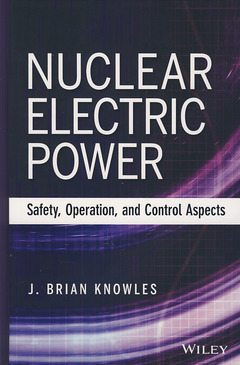Description
Nuclear Electric Power
Safety, Operation, and Control Aspects
Author: Knowles J. Brian
Language: English
Subjects for Nuclear Electric Power:
Keywords
grid operation, power stations, power grids, Three-Mile Island, Fukushima, Chernobyl, nuclear energy, non-linear dynamics, nuclear engineering, linearization techniques, nuclear reactors, Scram, power plant design, power plant operation, atmospheric fission, Farmer-Beattie plant, gas cooled reactors, AGR, Eigenvalues, geothermal, hydro, solar, tidal, and wind generation, molten fuel coolant interactions
232 p. · 16.4x24 cm · Hardback
Description
/li>Contents
/li>Biography
/li>
Assesses the engineering of renewable sources for commercial power generation and discusses the safety, operation, and control aspects of nuclear electric power
From an expert who advised the European Commission and UK government in the aftermath of Three Mile Island and Chernobyl comes a book that contains experienced engineering assessments of the options for replacing the existing, aged, fossil-fired power stations with renewable, gas-fired, or nuclear plants.
From geothermal, solar, and wind to tidal and hydro generation, Nuclear Electric Power: Safety, Operation, and Control Aspects assesses the engineering of renewable sources for commercial power generation and discusses the important aspects of the design, operation, and safety of nuclear stations.
Nuclear Electric Power offers:
- Novel, practical engineering assessments for geothermal, hydro, solar, tidal, and wind generation in terms of the available data on cost, safety, environmental damage, capacity factor reliability, and grid compatibility, with some nuclear comparisons
- Eigenvalues and real frequency response functions to assess the stabilities of reactor power, two-phase channel flow, and a Grid network
- A non-linear control strategy with simulation results for a Design Base Accident scenario
- Original analyses with experimental validation of molten fuel coolant interactions and aircraft impacts on rigid structures
- Analysis of the circumstances that led to the Fukushima disaster
Nuclear Electric Power is an important book for all international nuclear power agencies and those who work within the field.
Preface ix
Glossary xiii
Principal Nomenclature xv
1. Energy Sources, Grid Compatibility, Economics, and the Environment 1
1.1 Background 1
1.2 Geothermal Energy 3
1.3 Hydroelectricity 5
1.4 Solar Energy 7
1.5 Tidal Energy 8
1.6 Wind Energy 13
1.7 Fossil-Fired Power Generation 17
1.8 Nuclear Generation and Reactor Choice 20
1.9 A Prologue 30
2. Adequacy of Linear Models and Nuclear Reactor Dynamics 34
2.1 Linear Models, Stability, and Nyquist Theorems 34
2.2 Mathematical Descriptions of a Neutron Population 44
2.3 A Point Model of Reactor Kinetics 45
2.4 Temperature and Other Operational Feedback Effects 49
2.5 Reactor Control, its Stable Period and Re-equilibrium 51
3. Some Power Station and Grid Control Problems 56
3.1 Steam Drum Water-Level Control 56
3.2 Flow Stability in Parallel Boiling Channels 59
3.3 Grid Power Systems and Frequency Control 63
3.4 Grid Disconnection for a Nuclear Station with Functioning “Scram” 71
4. Some Aspects of Nuclear Accidents and Their Mitigation 79
4.1 Reactor Accident Classification by Probabilities 79
4.2 Hazards from an Atmospheric Release of Fission Products 82
4.3 Mathematical Risk, Event Trees, and Human Attitudes 84
4.4 The Farmer-Beattie Siting Criterion 87
4.5 Examples of Potential Severe Accidents in Fast Reactors and PWRs with their Consequences 93
5. Molten Fuel Coolant Interactions: Analyses and Experiments 101
5.1 A History and a Mixing Analysis 101
5.2 Coarse Mixtures and Contact Modes in Severe Nuclear Accidents 105
5.3 Some Physics of a Vapor Film and its Interface 110
5.4 Heat Transfer from Contiguous Melt 115
5.5 Mass Transfer at a Liquid–Vapor Interface and the Condensation Coefficient 121
5.6 Kinetics, Heat Diffusion, a Triggering Simulation, and Reactor Safety 124
5.7 Melt Fragmentation, Heat Transfer, Debris Sizes, and MFCI Yield 131
5.8 Features of the Bubex Code and an MFTF Simulation 140
6. Primary Containment Integrity and Impact Studies 148
6.1 Primary Containment Integrity 148
6.2 The Pi-Theorem, Scale Models, and Replicas 155
6.3 Experimental Impact Facilities 160
6.4 Computational Techniques and an Aircraft Impact 165
7. Natural Circulation, Passive Safety Systems, and Debris-Bed Cooling 173
7.1 Natural Convection in Nuclear Plants 173
7.2 Passive Safety Systems for Water Reactors 179
7.3 Core Debris-Bed Cooling in Water Reactors 181
7.4 An Epilogue 186
References 192
Index 207
J. Brian Knowles, PhD, DSc, now retired, remains professionally active with CEN Grenoble and KfK, where he compiled the results of European-wide MFCI experiments. In 1993, he visited the Russian Federation to discuss fast reactor collaboration as part of the European Commission's Whole Core Accident Committee and was later a member of the OECD-CSNI working group on water reactor accident management. Dr. Knowles was also a UKAEA Section Head of Thermal Dynamics at Winfrith, where he was responsible for a comprehensive modular simulation of intact plant dynamics used in AGR and proposed fast reactor designs.




